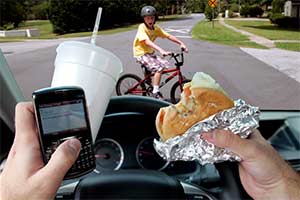Spotting risky behaviour crucial in cutting road accidents
Aggressive, risky behaviour is a clear predictor of accident-related events, according to a researcher at the UPV/EHU-University of the Basque Country
 A study published by a lecturer at the UPV/EHU’s Faculty of Education – Bilbao concludes that aggressive thoughts at the wheel lead to aggressive behaviour, which in turn unleashes risky behaviour associated with accident-related events. The study also shows that younger drivers experience more anger and express themselves more aggressively. By contrast, the differences between sexes are practically non-existent.
A study published by a lecturer at the UPV/EHU’s Faculty of Education – Bilbao concludes that aggressive thoughts at the wheel lead to aggressive behaviour, which in turn unleashes risky behaviour associated with accident-related events. The study also shows that younger drivers experience more anger and express themselves more aggressively. By contrast, the differences between sexes are practically non-existent.
Road safety and accident prevention are recurring, frequently explored subjects, although not always from the same perspective. It may be obvious that accident-related events are linked to risky behaviour and, in fact, “there are studies that link them together, but they have not been studied at the cognition or thought level. Traditionally, three factors have been cited to predict traffic accidents: the vehicle factor, the road factor and the human factor, and it has emerged in practically all the studies that the human factor is the most important one when predicting accidents. So that is where I have focussed my eight-year-long research,” explained David Herrero, author of the study and lecturer at the UPV/EHU’s Faculty of Education – Bilbao.
Three variables were measured: aggressive thoughts, risky behaviour and aggressive behaviour. “And we saw that accident-related events were related with aggressive behaviour, but above all with risky behaviour, although both factors could significantly predict traffic accidents. It could be said that aggressive thoughts entail aggressive behaviour and that this aggressive behaviour entails risky behaviour, which is associated with accident-related events,” explained Herrero.
414 people in possession of valid driving licences and who drive at least once a week participated in the study. They were interviewed by means of two questionnaires, “one to measure aggressive thoughts and the other to measure risky behaviour such as accident-proneness: the Driver’s Angry Thoughts Questionnaire and the Driving Survey. That way, we covered these three main blocks that we have explored in this study,” he said.
The study also analysed differences in terms of age and sex. With respect to age, they saw that “the youngest drivers are the ones most likely to experience anger and to express themselves aggressively, which is common in nearly all the studies. By contrast, the differences between the sexes are not that clear with respect to the expression and experience of anger, not even with respect to aggressive thoughts. We men and women have the same frequency of aggressive thoughts,” said Herrero.
Keys in cutting road accidents
The keys detected in this study could be useful not only in road safety but also in the area of clinical psychology. “Risky, aggressive behaviour in driving is a subject that has been little dealt with clinically, but what is true is that there is a small though significant percentage of drivers who are highly prone to behaving this way,” he explained.
According to the researcher, “it is important for us to know the cognitive, emotional and other mechanisms underlying this kind of behaviour to be able to intervene in the clearest, most precise way. Through the tools used, these processes can be assessed and clues provided on possible intervention. If a person says that in their real life and in driving he/she tends to behave aggressively in a specific way, we know that in the other context he/she is going to act in the same way”.
So David Herrero believes that “if we can make a person capable of spotting when he/she is behaving in a risky or even aggressive way, we will be reducing accident-related events. The main thing is to act on risky, aggressive behaviour more than on thoughts, even though one thing leads to the other,” he concluded.
Source: University of the Basque Country
Full bibliographic information:
Herrero-Fernandez D, Fonseca-Baeza S (2017). “Angry thoughts in Spanish drivers and their relationship with crash-related events. The mediation effect of aggressive and risky driving”. Accident Analysis & Prevention. Vol. 106. Pages 99–108. https://doi.org/10.1016/j.aap.2017.05.015

